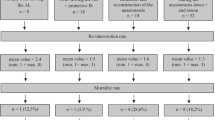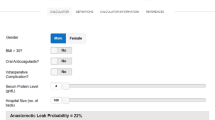Abstract
Introduction
Anastomotic leak (AL) is a significant cause of morbidity and mortality associated with complications of colorectal surgery. Furthermore, AL results in prolonged hospital stays and significant increase in costs of medical resources.
Materials and methods
In this study, we investigated the impact of anastomosis technique on the rate of anastomotic leak. The rate of leak was compared between two groups performing end-to-end (E-E) vs. side-to-end (S-E) anastomosis. The impact of various risk factors was also compared between the two groups.
Results
There were 382 E-E and 363 S-E anastomoses after left colectomy or rectal resections. The anastomotic leak rate was 8.64 % using E-E compared to 1.93 % using S-E anastomosis technique (p < 0.001).
Conclusions
These results indicate that the rate of anastomotic leak after left colon and rectum resections could be significantly reduced utilizing S-E anastomosis technique.











Similar content being viewed by others
References
Abete M, Ronchetti V, Casano A, Pescio G (2003) Anastomotic leakage after traditional surgery of the colon and rectum. Minerva Chir 58:167–174
Alberts JC, Parvaiz A, Moran BJ (2003) Predicting risk and deminishing the consequences of anastomotic dehiscence following rectal resection. Colorectal Dis 5:478–482
Alves A, Panis Y, Trancart D, Regimbeau J-M, Pocard M, Valleur P (2002) Factors associated with clinically significant anastomotic leakage after large bowel resection: multivariate analysis of 707 patients. World J Surg 26:499–502
Bernstein EF, Salomon GD, Harisiadis L, Talbot T, Harrington F, Russo A, Uitto J (1993) Collagen gene expression and wound strength in normal and radiation-impaired wounds. A model of radiation-impaired wound healing. J Dermatol Surg Oncol 19(6):564–570
Bokey EL, Chapuis PH, Fung C, Hughes WJ, Koorey SG, Brewer D, Newland RC (1995) Postoperative morbidity and mortality following resection of the colon and rectum for cancer. Dis Colon Rectum 38(5):480–486
Braun A, Flohr C, Hopt UT (2012) Endoskopischer Vakuum-assistierter Verschluss (VAC) bei Anastomoseninsuffizienzen nach anteriorer Rektumresektion. Z Gastroenterol. doi:10.1055/s-0032-1308813
Burns JL, Mancoll JS, Phillips LG (2003) Impairments to wound healing. Clin Plast Surg 30(1):47–56
Carus T, Emmert A (2011) Die laparoskopische Fluoreszenzangiographie mit Indocyaningrün zur intraoperativen Beurteilung der Perfusion bei kolorektalen Anastomosen. Z Gastroenterol. doi:10.1055/s-0031-1285178
Choi H-K, Law W-L, Ho JWC (2006) Leakage after resection and intraperitoneal anastomosis for colorectal malignancy: analysis of risk factors. Dis Colon Rectum 49:1719–1725
Eckmann C, Kujath P, Schiedeck TH, Shekarriz H, Bruch HP (2004) Anastomotic leakage following low anterior resection: results of s standardized diagnostic and therapeutic approach. Int J Dis 19:128–133
El Malt M, Ceelen W, van den Broecke C, Cuvelier C, Van Belle S, De Neve W, de Hemptinne B, Pattyn P (2001) Healing of experimental colonic anastomoses: effects of combined preoperative high-dose radiotherapy and intraperinoneal 5- fluorouracil. Int J Cancer 96(5):297–304
Elton C, Makin G, Hitos K, Cohen CRG (2003) Mortality, morbidity and functional outcome after ileorectal anastomosis. Br J Surg 90:59–65
Fink M (2011) Welsch, Büchler Anastomoseninsuffizienz im Gastrointestinaltrakt, Intensivmedizin up2date 7
Frieling T, Lüthen R, Heintges T, Niederau C, Oette M, Vogt C, Vom Dahl S (2011) Endoskopische Therapie von Leckagen im Gastrointestinaltrakt, an den Gallenwegen und im Pankreas. Z Gastroenterol 49(6):740–748
Furst MB, Stromberg BV, Blatchford GJ, Christensen MA, Thorson AG (1994) Colonic anastomoses: bursting strength after corticosteroid treatment. Dis Colon Rectum 37(1):12–15
Golub R et al (1997) J Am Surg 184:364–372
Hendriks T, Wobbes T, de Man BM, Hoogenhout J, Seifert WF (1998) Moderate doses of intraoperative radiation severely suppress early strength of anastomoses in the rat colon. Radiat Res 150(4):431–435
Herrle, F. Schattenberg T, Post S, Kienle P (2012) Verhindert die Omentumplastik Anastomoseninsuffizienzen in der colorektalen Chirurgie?- Ein systematisches Cochrane Review. Z Gastoenterol doi:10.1055/s-0032-1324320
Ito M et al (2009) Einfluss der Lernkurve auf Kurzzeitresultate nach laparoskopischer Resektion wegen Rektumkarzinom. Coloproctology 31(6):345–351
Jähne J (2010) Intestinale Anastomosentechniken. Der Chirurg 82:5–6. doi:10.1007/s00104-010-1904-8
Jahnson S, Holtz A, Gerdin B (1998) Anastomotic blood-flow reduction in rat small intestine with chronic radiation damage. Digestion 59(2):134–141
Johansson K, Ahn H, Herder A, Lindhagen J (1988) Assessment of gastrointestinal bloodflow with laser doppler flowmetry in patients with chronic radiation injury. Acta Chir Scand 154(4):291–296
Kehler A (2011) Wie unterscheiden sich Patienten mit Anastomoseninsuffizienzen hinsichtlich der Operationsmethode (offen vs. Laparoskopisch)? Inauguraldissertation der Universität Regensburg. urn:nbn:de:bvb:355-epub-214338
Kracht M, Hay JM, Fagniez PL, Fingerhut A (1993) Ileocolonic anastomosis after right hemicolectomy for carcinoma: stapled or hand-sewn? Int J Colorectal Dis 8(1):29–33
Köckerling F, Rose J, Schneider C, Scheidbach H, Scheuerlein H, Reymond MA, Reck T, Konradt J, Bruch HP, Zornig C (1999) Laparoscopic colorectal anastomosis: risk of postoperative leakage; Results of a multicenter study. Surg Endosc 13:639–644
Lang RA, Hüttl TP, Winter H, Meyer G, Jauch KW (2005) How safe are laparoscopic intracorporal anastomoses? Zentralbl Chir 130(1):65–70
Law WI, Chu KW, Ho JWC, Chan CW (2000) Risk factors for anastomotic leakage after low anterior resection for rectal cancer with total mesorectal excision. Am J Surg 179:92–96
Mann B, Blase M, Kranz D, Soenmez M Y (2012) Robotik-assistierte laparoskopische kolorektale Resektionen mit dem Da Vinci System-Erfahrungsbericht der ersten 73 Fälle. Z Gastroenterol. doi: 10.1055/s-0032-1323920
McLeod RS, Wolff BG, Ross S, Parkes R, McKenzie M, Investigators of the CAST rial (2009) Recurrence of Crohn’s disease after ileocolic resection is not affected by anastomotic type: results of a multicenter, randomized, controlled trial. Dis Colon Rectum 52(5):919–27
Platell C, Barwood N, Dorfmann G, Makin G (2007) The incidence of anastomotic leaks in patients undergoing colorectal surgery. Colorectal Dis 9:71–79
Polat A, Nayci A, Polat G, Aksoyek S (2002) Dexamethasone down-regulates endothelial expression of intercellular adhesion molecule and impairs the healing of bowel anastomoses. Eur J Surg 168(8–9):500–506
Rodriguez-Ramirez SE, Uribe A, Ruiz-Garcia EB, Labastida S, Luna-Perez P (2006) Risk factors for anastomotic leakage after preoperative chemoradiation therapy and low anterior resection with total mesorectal excision for locally advanced rectal cancer. Rev Invest Clin 58(3):204–210
Rullier E, Laurent C, Garrelon JL, Michel P, Saric J, Parneix M (1998) Risk factors for anastomotic leakage after resection of rectal cancer. Brit j surg 85:355–358
Seifert WF, Wobbes T, Hoogenhout J, de Man BM, Huyben KM, Hendriks T (1997) Intraoperative Sing, S., Cheng, T. The effect of systemic and local irradiation on wound macrophages and the repair promoting action of phenytoin sodium. Zhonghua Yi Xue Za Zhi 77(1):54–57
Sörensen LT, Jörgensen T, Kirkeby LT, Skovdal J, Vennits B, Wille-Jörgensen P (1999) Smoking and alcohol abuse are major risk factors for anastomotic leakage in colorectal surgery. Br J Surg 86:927–931
Takashi A et al (2011) Incidence of and risk factors for anastomotic leakage after laparoscopic anterior resection with intracorporeal rectal transection and double-stapling technique anastomosis for rectal cancer. Am J Surg 202(3):259–264
Wedemeyer J, Schneider AS, Winkler M, Manns MP (2011) Endoskopische Vakuumtherapie bei Perforationen und Anastomoseninsuffizienzen. Gastroenterologe 6(2):120–123
Weidenhagen R et al (2008) Endoluminale Vakuumtherapie im Management der Anastomoseninsuffizienz am oberen und unteren GI-Trakt. Endoskopie 21:30
Zurbuchen U, Kroesen AJ, Knebel P, Betzler MH, Becker H, Bruch HP, Senninger N, Post S, Buhr HJ, Ritz JP, German Advanced Surgical Treatment Study Group (2013) Complications after end-to-end vs. side-to-side anastomosis in ileocecal Crohn’s disease—early postoperative results from a randomized controlled multi-center trial Langenbecks. Arch Surg 398(3):467–74
Author information
Authors and Affiliations
Corresponding author
Rights and permissions
About this article
Cite this article
Shekarriz, H., Eigenwald, J., Shekarriz, B. et al. Anastomotic leak in colorectal surgery: are 75 % preventable?. Int J Colorectal Dis 30, 1525–1531 (2015). https://doi.org/10.1007/s00384-015-2338-z
Accepted:
Published:
Issue Date:
DOI: https://doi.org/10.1007/s00384-015-2338-z




